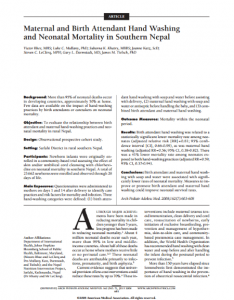
Background
More than 95% of neonatal deaths occur in developing countries, approximately 50% at home. Few data are available on the impact of hand-washing practices by birth attendants or caretakers on neonatal mortality.
Objective
To evaluate the relationship between birth attendant and maternal hand-washing practices and neonatal mortality in rural Nepal.
Design
Observational prospective cohort study.
Setting
Sarlahi District in rural southern Nepal.
Participants
Newborn infants were originally enrolled in a community-based trial assessing the effect of skin and/or umbilical cord cleansing with chlorhexidine on neonatal mortality in southern Nepal. A total of 23 662 newborns were enrolled and observed through 28 days of life.
Main Exposures
Questionnaires were administered to mothers on days 1 and 14 after delivery to identify care practices and risk factors for mortality and infection. Three hand-washing categories were defined: (1) birth attendant hand washing with soap and water before assisting with delivery, (2) maternal hand washing with soap and water or antiseptic before handling the baby, and (3) combined birth attendant and maternal hand washing.
Outcome
Measures Mortality within the neonatal period.
Results
Birth attendant hand washing was related to a statistically significant lower mortality rate among neonates (adjusted relative risk [RR] = 0.81; 95% confidence interval [CI], 0.66-0.99), as was maternal hand washing (adjusted RR = 0.56; 95% CI, 0.38-0.82). There was a 41% lower mortality rate among neonates exposed to both hand-washing practices (adjusted RR = 0.59; 95% CI, 0.37-0.94).
Conclusions
Birth attendant and maternal hand washing with soap and water were associated with significantly lower rates of neonatal mortality. Measures to improve or promote birth attendant and maternal hand washing could improve neonatal survival rates.